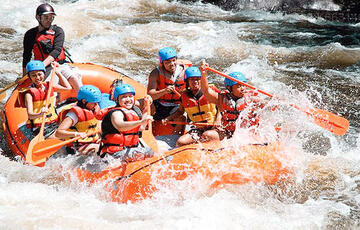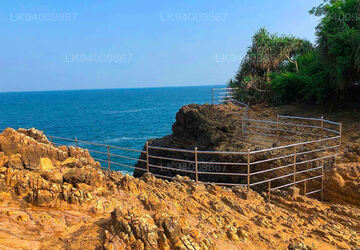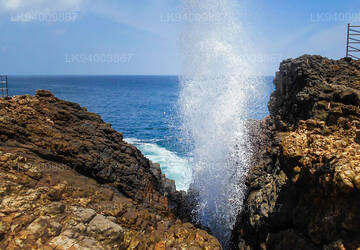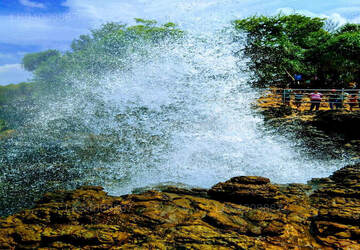
Tangalle City
Strung out along one of the South's most stunning stretches of coastline, TANGALLE (or Tangalla) is among the region’s more developed beach destinations, with a string of simple guesthouses – and a handful of upmarket hotels and villas – dotted along the coves and beaches which line the oceanfront here.
Hummanaya Blow Hole
Ein Blasloch ist ein geologisches Merkmal, das manchmal entlang von Küstenregionen vorkommt. Das Phänomen tritt auf, wenn die Flut Unterwasserhöhlen mit Meerwasser füllt. Die Höhlen sind durch einen geologischen Prozess der Küstenerosion entstanden. Dies kann durch „hydraulische Wirkung“ geschehen, bei der die Wellen Druck auf die Lufttaschen in den kleinen Rissen in der Klippe ausüben und diese weiter aufweiten; „Abrieb“ oder „Korrasion“, die dadurch verursacht wird, dass die Wellen Steine, Kieselsteine, Sand und anderes Material in die Klippe schlagen; chemische Verwitterung, die durch den Säuregehalt im Meerwasser verursacht wird und insbesondere für Gesteinszusammensetzungen wie Kalkstein tödlich ist; und „Abrieb“, ein Schleifeffekt, der durch kleine lose kreisförmige Gesteinstrümmer verursacht wird. Wenn die Kavernen eine oberirdische Öffnung haben; Durch den Druck wird das Wasser in regelmäßigen Abständen in einer Fontäne herausgedrückt oder „geblasen“. Der Zeitpunkt und die Höhe der Wasserfontänen aus diesen Blaslöchern hängen von den Gezeiten und Wellenformationen ab.
Zwar gibt es auf der ganzen Welt und insbesondere entlang der europäischen Küste viele Blaslöcher; Sri Lanka hat nur ein bekanntes Blasloch. Es liegt in der Nähe von Kudawella, einem kleinen Fischerdorf in der Südprovinz . Hummanaya kann durch Überqueren eines Tombolo erreicht werden; ein Stück Land, das durch die Ablagerung von Sand oder Kies entsteht und eine Insel mit dem Festland verbindet. Dieses Blasloch hat bei Besuchern der Insel Berühmtheit erlangt, da es vermutlich das zweitgrößte Blasloch der Welt ist. Benannt nach dem starken Summen, das es erzeugt, wenn es aktiv ist; Hummanaya Blowhole kann bis zu einer Höhe zwischen 25 und 30 m schießen.
About Hambantota District
Hambantota is a rural town in southeastern coastal area of Sri Lanka. It is also the capital of the Hambantota District in the Southern Province of Sri Lanka. Approximately 240 kms from Colombo, Hambantota is in the midst of transformation into a strategic port and commercial centre, undergoing extensive infrastructure development. Flanked by sweeping sandy beaches, Hambantota is a convenient location from which to visit nearby sights.
The Bundala National Park lays 20 km east of Hambantota and the Weerawila Sanctuary a little further off. The Ruhuna National Park and the Kataragama Temple are other attractions that can be accessed easily from this city.
About Southern Province
The Southern Province of Sri Lanka is a small geographic area consisting of the districts of Galle, Matara and Hambantota. Subsistence farming and fishing is the main source of income for the vast majority of the people of this region.
Important landmarks of the Southern Province include the wildlife sanctuaries of the Yala and Udawalawe National Parks, the holy city of Kataragama, and the ancient cities of Tissamaharama, Kirinda and Galle. (Although Galle is an ancient city, almost nothing survives from before the Portuguese invasion.) During the Portuguese period there were two famous Sinhalese poets called Andare who was from Dickwella and Gajaman Nona who was from Denipitiya in Matara District, composing poems on common man.



















